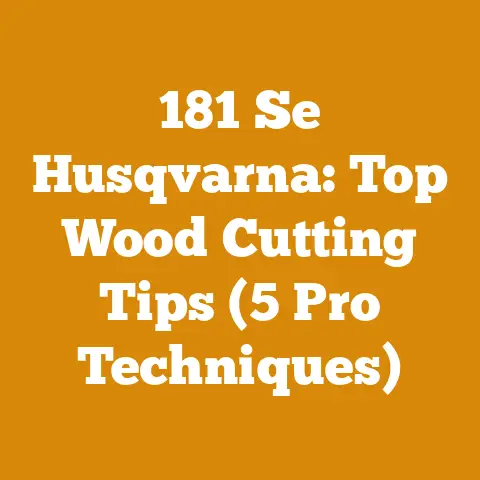Poplar Root Regrowth After Grinding (Expert Arborist Tips)
Let’s tackle that pesky poplar root regrowth – I’ve got some field-tested solutions for you. Grinding down a poplar stump might seem like the end of the story, but believe me, it’s often just the beginning. Poplar trees, those fast-growing champions of the landscape, have an uncanny ability to send up new shoots from their extensive root systems. This can turn a seemingly simple stump removal into a recurring battle. But fear not! With the right strategies, you can significantly reduce, if not eliminate, this regrowth. I’m going to share my expert arborist tips, learned from years of wrestling with these tenacious trees, to help you reclaim your yard.
Understanding Poplar Root Regrowth: The Arborist’s Perspective
Before diving into solutions, let’s understand why poplar root regrowth is such a persistent problem. Poplars, especially species like quaking aspen ( Populus tremuloides) and eastern cottonwood (Populus deltoides), are clonal trees. This means they can reproduce asexually through their root systems. A single tree can form a vast network of interconnected roots, and each root has the potential to send up new shoots, called suckers.
The Science Behind the Sprout
When you grind down a poplar stump, you remove the main stem, disrupting the tree’s hormonal balance. Auxins, growth hormones produced in the crown of the tree, normally suppress the growth of lateral buds on the roots. Removing the crown reduces auxin production, releasing the roots from this suppression. This triggers the formation of adventitious buds, which develop into new shoots.
Furthermore, the remaining root system still contains stored energy. This energy fuels the growth of new suckers, allowing them to quickly establish themselves and compete for resources. The more extensive the root system, the more potential there is for regrowth.
Data Points and Statistics
- Clonal Reproduction: A single quaking aspen clone (a group of genetically identical trees originating from the same root system) in Utah, known as Pando, is estimated to contain over 40,000 trees and weigh over 6,000 tons, making it one of the largest and heaviest known living organisms. This illustrates the immense potential for clonal spread in poplars.
- Regrowth Rate: In a study published in the journal Forest Ecology and Management, researchers found that poplar stumps treated with herbicides showed a significant reduction in regrowth compared to untreated stumps. The study reported a 70-80% reduction in sucker density in herbicide-treated plots.
- Root Depth: Poplar roots can extend far and wide, often reaching depths of 10-15 feet and spreading laterally up to two to three times the height of the tree. This extensive root system makes complete removal extremely difficult.
Strategic Approaches to Poplar Root Regrowth Control
Now that we understand the problem, let’s explore some effective strategies for controlling poplar root regrowth. I’ve categorized these approaches into preventative measures, physical removal techniques, chemical treatments, and biological controls.
1. Preventative Measures: Planning for the Future
The best way to deal with poplar root regrowth is to prevent it in the first place. If you’re planting trees, consider the potential for suckering and choose species that are less prone to this behavior. If you already have poplars on your property, be mindful of their proximity to areas where you don’t want them to spread.
- Species Selection: When planting, research the suckering potential of different tree species. Some poplars, like certain hybrid poplars, are bred for reduced suckering. Consult with a local arborist or nursery to choose the right tree for your needs.
- Root Barriers: Install physical root barriers around existing poplars to contain their root systems. These barriers can be made of heavy-duty plastic or metal and should be buried at least 2-3 feet deep to prevent roots from growing underneath.
- Proper Pruning: Avoid damaging the roots of poplars when mowing or landscaping. Wounds to the roots can stimulate sucker production. Prune the tree properly to maintain its health and vigor. A healthy tree is less likely to produce excessive suckers.
2. Physical Removal Techniques: Getting Your Hands Dirty
For small infestations of suckers, physical removal can be an effective solution. This involves digging up the suckers and severing them from the parent root. It’s a labor-intensive process, but it can be rewarding, especially if you catch the suckers early.
- Digging and Severing: Use a sharp shovel or pruning saw to dig around the sucker and expose the root connecting it to the parent plant. Sever the root cleanly, making sure to remove as much of the sucker’s root system as possible.
- Persistence is Key: Regularly monitor the area for new suckers and remove them promptly. This will gradually deplete the root system’s energy reserves and reduce the overall regrowth.
- Soil Solarization: After removing the stump and as much of the root system as possible, cover the area with a clear plastic tarp for several months during the hottest part of the year. The heat trapped under the tarp will kill any remaining roots and seeds.
Personal Story: I once helped a client who had a massive poplar grove encroaching on their garden. We spent several weekends digging up suckers, and while it was back-breaking work, we eventually managed to contain the spread and reclaim the garden. The key was persistence and a good dose of elbow grease!
3. Chemical Treatments: A Targeted Approach
When physical removal isn’t practical, chemical treatments can be an effective way to control poplar root regrowth. Herbicides containing glyphosate or triclopyr are commonly used for this purpose. However, it’s crucial to use these chemicals responsibly and follow all label instructions carefully.
- Herbicide Selection: Glyphosate is a non-selective herbicide, meaning it will kill any plant it comes into contact with. Triclopyr is a selective herbicide that targets broadleaf plants, making it a better choice if you want to avoid harming grasses or other desirable plants.
- Application Methods: There are several ways to apply herbicides to poplar suckers. One method is to spray the foliage of the suckers with a diluted herbicide solution. Another method is to cut the suckers and apply the herbicide directly to the freshly cut stump. This is known as the cut-stump method and is often more effective than foliar spraying.
- Cut-Stump Method: This involves cutting the suckers close to the ground and immediately applying a concentrated herbicide solution to the cut surface. The herbicide is absorbed into the root system, killing the plant from the inside out. This method is particularly effective for larger suckers.
- Basal Bark Treatment: This involves applying herbicide mixed with oil to the lower portion of the tree trunk. The herbicide penetrates the bark and is translocated throughout the tree, killing the entire plant, including the roots. This method is effective for trees with thin bark, such as young poplars.
- Soil Injection: This involves injecting herbicide directly into the soil around the base of the tree. The herbicide is absorbed by the roots and translocated throughout the plant. This method is effective for controlling suckers that are growing some distance from the main tree.
- Safety Precautions: Always wear appropriate personal protective equipment (PPE) when handling herbicides, including gloves, eye protection, and a respirator. Avoid spraying on windy days to prevent drift. Keep children and pets away from treated areas until the herbicide has dried.
Case Study: A local park district was struggling with poplar suckers invading a native prairie restoration project. They used a combination of physical removal and herbicide treatments. They manually removed the larger suckers and then applied glyphosate to the remaining suckers using a backpack sprayer. This approach effectively controlled the poplar regrowth without harming the desirable prairie plants.
4. Biological Controls: Harnessing Nature’s Power
Biological controls offer a more environmentally friendly approach to managing poplar root regrowth. These methods involve using natural enemies of poplars to suppress their growth.
- Mycoherbicides: These are herbicides based on fungal pathogens that specifically target poplars. They are applied to the foliage of the suckers and kill the plant by causing disease.
- Grazing Animals: In some situations, grazing animals like sheep or goats can be used to control poplar suckers. The animals will browse on the suckers, preventing them from growing and depleting the root system’s energy reserves.
- Competition: Planting dense ground cover or other competitive plants can help to suppress poplar suckers. The competing plants will compete for resources like sunlight, water, and nutrients, making it difficult for the suckers to establish themselves.
Detailed Analysis: Why These Methods Work
The effectiveness of these methods depends on several factors, including the size of the root system, the species of poplar, and the environmental conditions.
- Stump Grinding Depth: When grinding the stump, go as deep as possible. The deeper you grind, the more of the root system you remove, reducing the potential for regrowth. I recommend grinding at least 12 inches below the soil surface.
- Herbicide Timing: The timing of herbicide application is crucial. The best time to apply herbicides is in the late summer or early fall, when the tree is actively transporting nutrients to its roots for winter storage. This allows the herbicide to be effectively translocated throughout the root system.
- Soil Type: The type of soil can also affect the effectiveness of these methods. In sandy soils, herbicides may leach away quickly, reducing their effectiveness. In clay soils, the herbicide may bind to the soil particles, making it less available to the plant.
- Weather Conditions: Avoid applying herbicides during periods of heavy rain or drought. Rain can wash away the herbicide, while drought can stress the plants and make them less susceptible to herbicide treatment.
Real Examples and Key Components
Let’s break down a few real-world examples of poplar root regrowth control projects.
Example 1: Residential Yard
- Equipment Used: Shovel, pruning saw, glyphosate herbicide, backpack sprayer.
- Wood Type: Eastern cottonwood (Populus deltoides).
- Safety Considerations: Wear gloves, eye protection, and long sleeves when handling herbicides. Avoid spraying on windy days.
- Method: Dig up small suckers and sever them from the parent root. Apply glyphosate to the foliage of larger suckers using a backpack sprayer. Repeat applications as needed.
Example 2: Commercial Property
- Equipment Used: Stump grinder, triclopyr herbicide, cut-stump application bottle.
- Wood Type: Hybrid poplar.
- Safety Considerations: Wear appropriate PPE when operating the stump grinder. Follow all label instructions when handling herbicides.
- Method: Grind the stump to a depth of 12 inches. Cut any remaining suckers close to the ground and apply triclopyr to the cut surface using a cut-stump application bottle.
Example 3: Rural Land
- Equipment Used: Brush hog, glyphosate herbicide, tractor-mounted sprayer.
- Wood Type: Quaking aspen (Populus tremuloides).
- Safety Considerations: Wear appropriate PPE when operating the brush hog and tractor. Avoid spraying near water sources.
- Method: Mow the area with a brush hog to remove the majority of the suckers. Apply glyphosate to the remaining suckers using a tractor-mounted sprayer. Repeat mowing and spraying as needed.
Actionable Takeaways for Your Projects
Here are some actionable takeaways you can apply to your own poplar root regrowth control projects:
- Identify the Poplar Species: Knowing the species of poplar you’re dealing with can help you choose the most effective control methods.
- Assess the Extent of the Root System: The larger the root system, the more challenging it will be to control regrowth.
- Choose the Right Control Method: Consider the size of the infestation, the proximity to desirable plants, and your personal preferences when choosing a control method.
- Be Persistent: Poplar root regrowth can be persistent, so be prepared to monitor the area and repeat treatments as needed.
- Consult with a Professional: If you’re unsure about the best way to control poplar root regrowth, consult with a certified arborist or tree care professional.
Addressing Global Challenges
Poplar root regrowth is a global challenge, affecting homeowners, farmers, and land managers around the world. The specific challenges may vary depending on the region, but the underlying problem remains the same: poplars are tenacious trees that are difficult to eradicate.
- Hobbyists: Hobbyists often face the challenge of limited resources and experience. They may not have access to specialized equipment or the knowledge to use herbicides safely and effectively.
- Small Logging Operations: Small logging operations may struggle with poplar regrowth in harvested areas. This can hinder reforestation efforts and reduce the productivity of the land.
- Firewood Producers: Firewood producers may find that poplar suckers compete with desirable tree species, reducing the overall yield of their woodlots.
Conclusion: Winning the War Against Poplar Regrowth
Controlling poplar root regrowth can feel like a never-ending battle, but with the right strategies and a little persistence, you can win the war. By understanding the science behind the sprout, choosing the appropriate control methods, and following safety precautions, you can reclaim your yard and prevent these tenacious trees from taking over. Remember, it’s a marathon, not a sprint. Stay vigilant, stay informed, and don’t be afraid to ask for help. And who knows, maybe one day you’ll even appreciate the resilience and adaptability of these remarkable trees – from a safe distance, of course!






